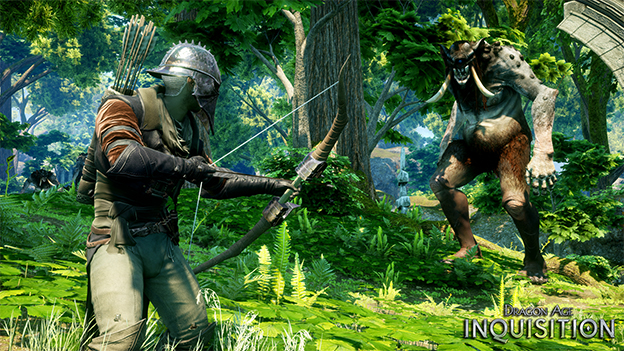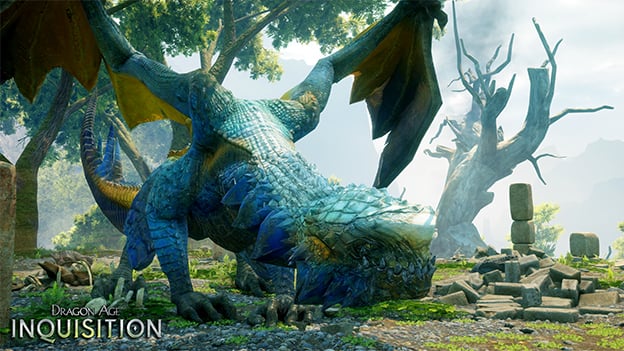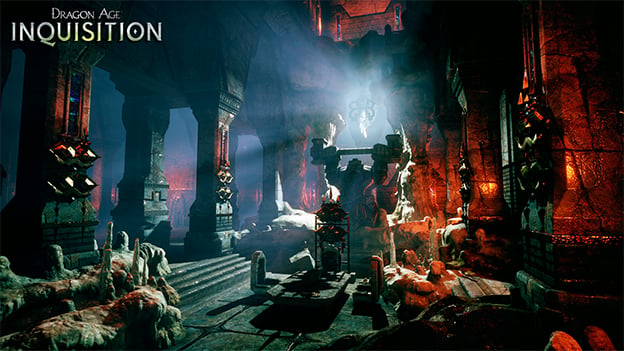Join the Inquisition
The truth about the Dragon Age franchise is that it has struggled to find its footing from the very beginning. Dragon Age: Origins garnered a good amount of followers, but never accumulated a large fan base. Dragon Age II , while popular among some players, was received with mixed reviews by both players and critics. It feels like Dragon Age: Inquisition suffers from the same issues as its predecessors – feeling and playing like a different game instead of the next installation in a series.
Honestly, Dragon Age: Inquisition feels more like Mass Effect 3 than anything. The game follows a heroic protagonist that must rally the forces of the in-game world to amass an army capable of taking on the greater evil of the land. In addition to this, you gather legendary heroes to add to the Inquisition, similar to building your team in Mass Effect 2 and 3 . It feels like BioWare decided to go with what worked for Mass Effect , while still attempting to inject some new dynamics into the game, but the game mechanics felt like the first game in a series instead of the third.
With all that being said, BioWare did attempt to do some things that were completely different for the Dragon Age series. First and foremost, setting it in an open world. This has been a long time coming for the Dragon Age series, with Dragon Age II feeling completely closed in and Origins having its linear feel. The open world of Inquisition gives you the ability play for the objectives you wish, without requiring you to play through the main story. Of course, advancing through main story missions will progress the game and open up new areas, but there is still plenty to do in terms of side quests and collecting. This portion of Inquisition seems to draw some inspiration from the Elder Scrolls series in regard to its open setting.
Next, a revised combat system has come into play. Not as straightforward as previous games in the series, this combat system diversifies how you can play the game fairly dramatically, if you wish to use it. For the most part it will seem familiar, powers and/or attacks are mapped to face and trigger buttons on your controller, while items and inventory are controlled from sub-menus. The true difference of Inquisition is its Tactics mode gameplay. This gives you the ability to see the battlefield from above, assigning orders to your characters while controlling the progression of time. Basically, you move time forward by holding down the right trigger button, giving you the ability to issue orders to characters on the fly or from a paused moment in the battle. This can be extremely useful, albeit boring, in combat.

I found myself only using this functionality in the direst of circumstances, instead letting AI programming take care of my counterparts and playing as my avatar. As I said, this does open up the combat gameplay quite a bit, but it wasn’t particularly fun.
However, in true BioWare fashion, you can customize your character to match your fantasy experience. Character creation was a “gimme” for this game because without it, it wouldn’t feel like a BioWare game. Just select the character archetype you are used to and roll out. Don’t worry though, if you need some variety in the gameplay later on you can switch between characters in your party easily enough. I’ve always been partial to the Fighter/Warrior/Barbarian/Whatever character in any fantasy game, so I went with that. Skill trees are used to progress your digital hero, corresponding to your class of course. As you might expect, leveling up gives you points to spend how you see fit, so choose wisely early on.

From an overall gameplay standpoint, Dragon Age: Inquisition does well enough to keep the game engaging, but it’s not going to set any trends either. You may find the exploration and collecting mechanics relatively engaging for a while, but they will wear thin soon enough, at least they did for me. I found myself moving from story point to story point pretty quickly, with little regard for side missions if they were at all out of my way. However the shear breadth of content available is enormous, giving those who wish to complete it a ton to do in Inquisition .
The gameplay is supported by visuals that, to me, weren’t particularly impressive. With the processing power of the current generation of consoles and PC’s, I saw way too many visual errors in my Inquisition experience. It was truly odd. It was like the character models and environments were from the last generation of consoles, with a fresh veneer of visual effects laid over them. For example, shadows and lighting effects were excellent and functioned near flawlessly, but the character animations were stiff and uninspired, showing detail in some situations and looking lackluster in others.
Add to that screen tearing between cutscenes and gameplay sequences, as well as odd world glitches (I literally saw NPC’s falling from the sky to land on their designated spots in the world at several points) and what you have is a game that could have been visually breathtaking, but falls just short.
But, where the visuals fail to impress, the soundscape shines in its place. The overall score and tone of the game are pretty much spot on, with excellent voice acting and sound effects to back it up. All characters have a voice in Inquisition , as they should, which helps to offset some of the other issues the game has. The sound helps to balance out what would otherwise feel like an incomplete experience.

When I started playing Dragon Age: Inquisition and my opinion started forming, I felt like I was being overly critical and harsh. As I got into the meat of the game, the issues I’ve stated above continued to rear their ugly heads, but in the end the game still manages to pull off being an enjoyable experience. What Dragon Age: Inquisition lacks in polish it makes up for in its content.
There is simply a truckload of things to do in Inquisition , far more than any of the previous Dragon Age games. It takes a page from Mass Effect 3 in its configuration, which isn’t necessarily a bad thing, and adds a lot of the standard open world style item collection and mission structure to the mix.
So, after all is said and done, Dragon Age: Inquisition will most likely suffer the same fate as its predecessors. It’s a fun game that will probably never achieve a broad fan base, but there will be those that love the game and will go to great lengths to defend it with rabid aggression. All told, I was expecting more but I’m not really that surprised. I had fun and that’s what counts.
RATING OUT OF 5 RATING DESCRIPTION 3.0 Graphics
Not as “next-gen” as I would’ve hoped. 3.8 Control
Pretty standard with the injection of a few new ideas. 4.0 Music / Sound FX / Voice Acting
Solid, but not enough to make this a “great” game. 4.0 Play Value
There is a ton to do, it’s just not all fun. There will be those that love this game though. 3.8 Overall Rating – Good
Not an average. See Rating legend below for a final score breakdown.
| Review Rating Legend | |||
|---|---|---|---|
| 0.1 – 1.9 = Avoid | 2.5 – 2.9 = Average | 3.5 – 3.9 = Good | 4.5 – 4.9 = Must Buy |
| 2.0 – 2.4 = Poor | 3.0 – 3.4 = Fair | 4.0 – 4.4 = Great | 5.0 = The Best |
Game Features:
